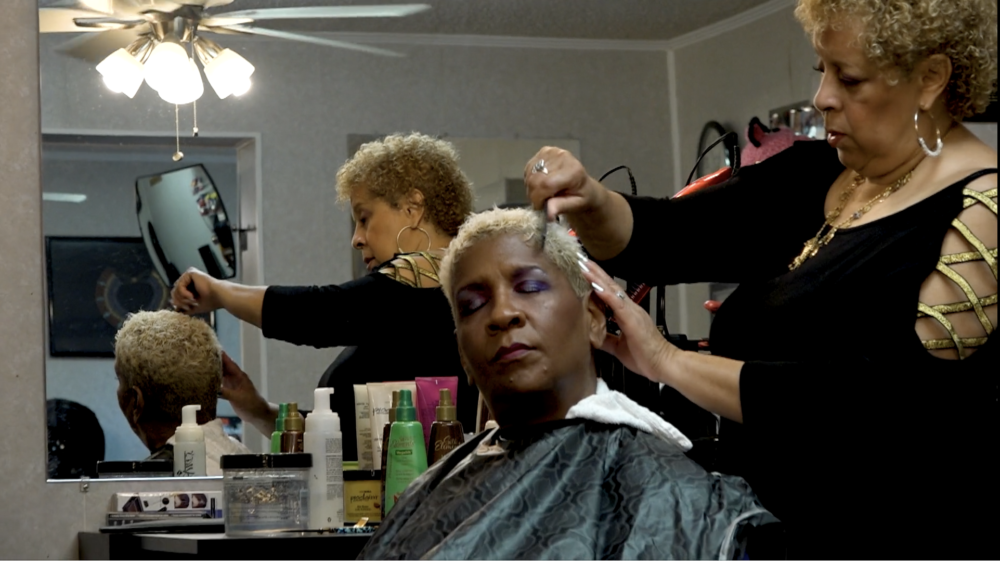For Day With(out) Art 2017, Visual AIDS commissioned seven new and innovative short videos from artists Mykki Blanco, Cheryl Dunye & Ellen Spiro, Tourmaline, Thomas Allen Harris, Kia LaBeija, Tiona Nekkia McClodden and Brontez Purnell. Curated by Erin Christovale and Vivian Crockett for Visual AIDS, the video program ALTERNATE ENDINGS, RADICAL BEGINNINGS prioritized Black narratives within the ongoing AIDS epidemic.
Below, Darius Bost responds to Cheryl Dunye & Ellen Spiro's, "DiAna's Hair Ego REMIX." Read Cheryl Dunye & Ellen Spiro's artist statement here.
The Art of Remixing: Cheryl Dunye & Ellen Spiro's "DiAna's Hair Ego REMIX"
by Darius Bost
In 1989, Ellen Spiro directed the short film, DiAna’s Hair Ego: AIDS Info Up Front, which documents the AIDS education and prevention efforts of two black women in Columbia, South Carolina—cosmetologist DiAna DiAna, and public health educator Dr. Bambi Gaddist. The film focuses on their grassroots activism, based in DiAna’s hair salon, DiAna’s Hair Ego. According to historian Tanisha C. Ford, beauty shops have long been places of refuge and sisterhood for black women, and during the Civil Rights era became a space to organize and mobilize other women, and a space to find emotional support in the face of the demoralizing violence of racism and sexism.1 DiAna and Bambi extend this work into the early era of the AIDS epidemic, focusing on sex positive prevention and education strategies, and a holistic approach to health in the midst of racial, gender, sexual, and regional ideologies that rendered Southern black heterosexual women an invisible, yet highly vulnerable population impacted by AIDS. What stood out to me most about the film was their creative educational and prevention strategies. The team used innovative methods to teach black women and men to say words like fellatio and cunnilungus, things rarely talked about, but certainly performed in black Southern communities. DiAna and Bambi also administered programs and created coloring books for local school-aged children to teach them about the pleasures and dangers of sex. Their pioneering approach to sex education filled a gap between state-produced knowledge about sex, sexual identities, and sexual health, and black sexual cultures and practices in the urban South.
In 2017, for Visual AIDS’ Day With(out) Art
ALTERNATE ENDINGS, RADICAL BEGINNINGS, Spiro and fellow feminist filmmaker Cheryl Dunye (The Watermelon Woman; Stranger Inside), created a follow-up short film, titled DiAna’s Hair Ego REMIX, which revisited DiAna DiAna and Bambi Gaddist at DiAna’s Hair Ego salon thirty years later. Displayed in white font on the black spaces of the film are a number of recent statistics representing the devastating impact of HIV/AIDS in black communities. According to a 2017 South Carolina Department of Health and Environmental Control report, black people make up 28% of the population of South Carolina, but make up 69% of people living with HIV. While the rate of new infections for African American women has declined since the early years of the epidemic, they are still disproportionately affected in terms of the number of people living with HIV/AIDS and in the rate of newly diagnosed cases. Black men in the United States currently comprise the greatest number of new diagnoses, the highest proportion of people living with HIV/AIDS, and the highest percentage of people who die from AIDS related complications.2 In DiAna’s Hair Ego REMIX, Dr. Gaddist expresses frustration with these abysmal statistics, after thirty years of activism, and due to the lack of public interest regarding AIDS, now that the face of HIV/AIDS has changed from white gay men to poor people of color, across genders and sexualities, particularly in the American South and global South.

